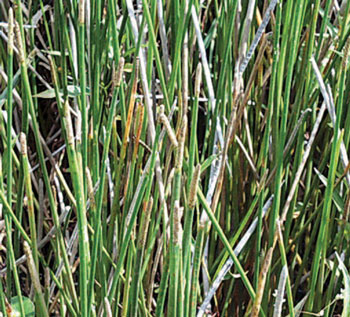Horsetail Spike-rush government response statement
Ontario’s policy direction for the protection and recovery of Horsetail Spike-rush.
Publication date: September 7, 2012

Photo: Shirley Denton
Horsetail Spike-rush is an aquatic plant in the sedge family that is found primarily within coastal plains. In southwestern Ontario, the species grows in organic substrate and is located in a pond between forested dunes at Long Point National Wildlife Area.
Protecting and recovering Species at Risk in Ontario
Species at risk recovery is a key part of protecting Ontario’s biodiversity. Biodiversity – the variety of living organisms on Earth – provides us with clean air and water, food, fibre, medicine and other resources that we need to survive.
The Endangered Species Act, 2007 (ESA) is the Government of Ontario’s legislative commitment to protecting and recovering species at risk and their habitats. As soon as a species is listed as extirpated, endangered or threatened under the ESA, it is automatically protected from harm or harassment. Also, immediately upon listing, the habitats of endangered and threatened species are protected from damage or destruction.
Under the ESA, the Ministry of Natural Resources (the Ministry) must ensure that a recovery strategy is prepared for each species that is listed as endangered or threatened. A recovery strategy provides science-based advice to government on what is required to achieve recovery of a species.
Government response statements
Within nine months after a recovery strategy is prepared, the ESA requires the Ministry to publish a statement summarizing the government’s intended actions and priorities in response to the recovery strategy. The recovery strategy for the Horsetail Spike-rush was published on December 7, 2011 (Horsetail Spike-rush Recovery Strategy).
The response statement is the government’s policy response to the scientific advice provided in the recovery strategy. In addition to the strategy, the response statement is based on input from stakeholders, other jurisdictions, Aboriginal communities and members of the public. It reflects the best available traditional, local and scientific knowledge at this time and may be adapted if new information becomes available. In implementing the actions in the response statement, the ESA allows the Ministry to determine what is feasible, taking into account social and economic factors.
Moving forward to protect and recover Horsetail Spike-Rush
Horsetail Spike-rush is listed as an endangered species under the ESA, which protects both the plant and its habitat. The ESA prohibits harm or harassment of the species and damage or destruction of its habitat without authorization. Such authorization would require that conditions established by the Ministry be met.
Horsetail Spike-rush is found primarily within the Atlantic and Gulf coastal plains. At the northern extent of its range, the species has been found along the southern Great Lakes. The sole occurrence of Horsetail Spike-rush in Canada lies within the federally protected Long Point National Wildlife Area. Possible threats to Horsetail Spike-rush include invasion by the European Common Reed (Phragmites australis subspecies australis), browsing by white-tailed deer, changes in water levels, and genetic loss.
Due to the distribution of the species, the federal government will be leading recovery efforts for the Horsetail Spike-rush.
The Government of Ontario’s goal for the recovery of Horsetail Spike-rush is to ensure the persistence of the single existing population in Ontario.
Protecting and recovering species at risk is a shared responsibility. No single agency or organization has the knowledge, authority or financial resources to protect and recover all of Ontario’s species at risk. Successful recovery requires inter-governmental co-operation and the involvement of many individuals, organizations and communities.
In developing the government response statement, the Ministry considered what actions are feasible for the government to lead directly and what actions are feasible for the government to support its conservation partners to undertake.
Government-led actions
To help protect and recover Horsetail Spike-rush, the government will directly undertake the following actions:
- Co-operate with federal partners where appropriate to implement protection and recovery actions identified in the "Action Plan for the Horsetail Spike-rush" by Environment Canada.
- Encourage the submission of Horsetail Spike-rush data to the Ministry’s central repository at the Natural Heritage Information Centre.
- Protect Horsetail Spike-rush and its habitat through the ESA.
Implementing actions
Implementation of the actions may be subject to changing priorities across the multitude of species at risk, available resources and the capacity of partners to undertake recovery activities. Where appropriate, the implementation of actions for multiple species will be co-ordinated across government response statements.
The Ministry can advise if any authorizations under the ESA or other legislation may be required to undertake the project.
Reviewing progress
The ESA requires the Ministry to conduct a review of progress towards protecting and recovering a species not later than five years from the publication of this response statement. The review will help identify if adjustments are needed to achieve the protection and recovery of Horsetail Spike-rush.
Acknowledgement
We would like to thank all those who participated in the development of the "Recovery Strategy for the Horsetail Spike-rush in Ontario" for their dedication to protecting and recovering species at risk.